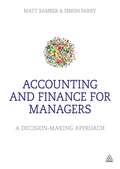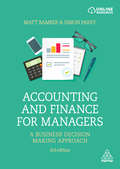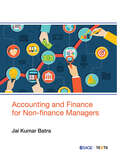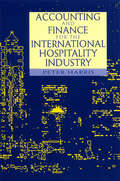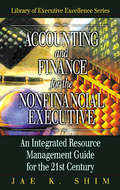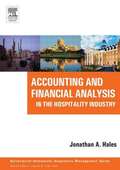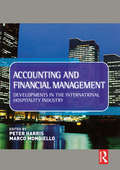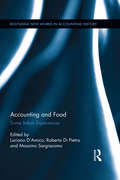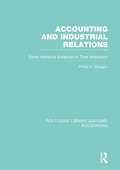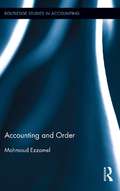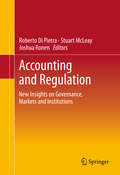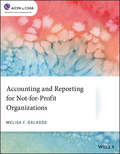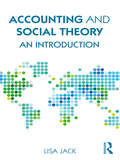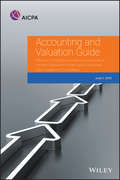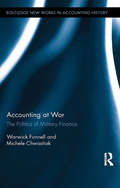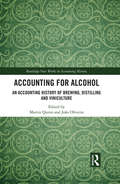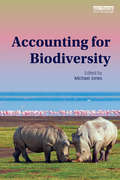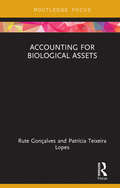- Table View
- List View
Accounting and Finance for Managers
by Matt Bamber Simon ParryAccounting and Finance for Managers is a new text specifically designed to improve analytical skills and help readers use accounting and finance tools for managerial advantage. Ideal for self study as well as classroom learning, it includes worked examples throughout the chapters as well as real-world scenarios and full exercises at the end of each chapter. Providing coverage of basic bookkeeping, readers will learn how to interpret financial statements and grasp underlying theory, interpret a cash budget and identify potential problems, identify appropriate pricing strategies to fit different markets and products/services and incorporate financial evaluation into operational decision making and problem solving. With full supporting resources including lecture slides for each chapter and a breakdown of how each chapter relates to course structures, Accounting and Finance for Managers is essential reading for any student or manager.
Accounting and Finance for Managers: A Business Decision Making Approach
by Matt Bamber Simon ParryAccounting and Finance for Managers rebukes the myth that in order to excel in accounting and finance you need to be great at mathematics. Split into two broad sections which focus on financial accounting and management accounts, this textbook uses clear, accessible language that will appeal to students from a variety of academic backgrounds.Taking a uniquely practical approach that focuses on the financial aspects of business decisions, the textbook covers all the core topics of accounting and finance, including basic bookkeeping, financial analysis, business planning, cash-flow analysis and investment decisions. Now in its third edition, Accounting and Finance for Managers contains updates on new accounting standards and regulations, as well as featuring up-to-date real-world examples of real options, value chain analysis and competitive advantage analysis. This textbook features 'traditional' accounting practices in detail, but also covers topics with a strategic focus to ensure students learn to think in broader strategic terms. Written for an international audience using International Financial Reporting Standards (IFRS) terminology with supporting resources including additional exercise questions, curated further reading and lecture slides for each chapter.
Accounting and Finance for Managers: A Business Decision Making Approach
by Matt Bamber Simon ParryThe ideal textbook for business and management students needing to develop and understand accounting and finance skills. Taking a unique and practical approach that focuses on the financial aspects of business decisions, Accounting and Finance for Managers covers the core topics of accounting and finance. Now in its fourth edition, it includes new advice on budgetary control, outlining new techniques and emerging methods to help students understand how to make better business decisions.Featuring 'traditional' accounting practices in detail, Accounting and Finance for Managers covers topics with a strategic and accessible focus. With new content covering essential tools such as contribution and breakeven analysis and the growing presence of automation and machine learning, this is an essential textbook for business and management students on accounting and finance modules. Supporting online resources include additional exercise questions, curated further reading and lecture slides for each chapter.
Accounting and Finance for Managers: A Decision-Making Approach
by Matt Bamber Simon ParryAccounting and Finance for Managers is specifically designed for MBA, EMBA, MA and MSc Business and Management students who require a grounding in the key concepts of accounting and finance. Including real financial statements and worked examples from well-known businesses, as well as full exercises and questions at the end of each chapter, this accessible guide provides students with the financial tools and analytical skills for managerial advantage. Taking a uniquely practical approach that focuses on the financial aspects of business decisions, the book covers all the core topics of accounting and finance, including basic bookkeeping, financial analysis, business planning, cash-flow analysis, and investment decisions. Now in its second edition, Accounting and Finance for Managers contains updated examples and case studies from Burberry, Ryanair and Whitbread, new content on corporate governance and ratio analysis, reflective activities and a new chapter on financing decisions. Bonus online material includes guidance and teaching advice, additional questions and lecture slides for each chapter.
Accounting and Finance for Non-finance Managers
by Jai Kumar BatraDesigned for management students from a non-finance background, this book introduces the basic concepts of accounting and finance in an easy-to-understand manner. The book comprehensively covers the fundamental concepts of financial accounting, cost accounting, management accounting and financial management. It also introduces international accounting standards covering US GAPP and IFRS. Accounting and Finance for Non-finance Managers helps to develop the generic skills of application, problem-solving, evaluation and communication in the areas of accounting and finance to aid young managers in making appropriate business decisions. Key Features: Text and theory supported by numerous examples, diagrams, activities, solved illustrations, practice modules, unsolved exercises, case studies and suggestions for project work. Cases and examples extracted from newspapers, annual reports and financial reports of real-time companies to help practical understanding. Robust companion website including additional solved illustrations, test bank, PPTs and manuals for classroom teaching.
Accounting and Finance for the International Hospitality Industry
by Peter HarrisTop experts specializing in hospitality management have contributed articles to this new collection which explains recent developments in accounting and finance. The material is drawn from a combination of fieldwork and practical experience. The managerial emphasis means that the content is fully relevant internationally and not constrained by the legal framework of different countries. Accounting and Finance provides an overview of:*analysis and evaluation of performance *planning methods and techniques *financial information and control *financial management. It also shows how operational analysis can be used as a management tool to improve performance. Techniques for predicting the financial success or failure of hotels are suggested. Research into hotel companies in the US and Europe demonstrates key performance indicators used by hotel managers and financial executives. Other contributors explore the interface between accounting and marketing and human resource management and there is thorough coverage of financial strategy formulation. Readers will also find helpful the section on statistics in the analysis and prediction of cost behaviour in hotels.Contributors: Raymond Schmidgall (Michigan State University, USA); Debra J. Adams (Bournemouth University, UK); Professor Elisa S. Moncarz (Florida International University, USA); Richard N. Kron (Kron Hospitality Consulting, USA); Angela Maher (Oxford Brookes University, UK); Peter J. Harris (Oxford Brookes University, UK); Geoff S. Parkinson (BDO Stoy Hayward Chartered Accountants, UK); Paul Fitz-John (Bournemouth University, UK); Paul Collier (University of Exeter, UK); Professor Alan Gregory (University of Glasgow, UK); Tracy A. Jones (Cheltenham and Gloucester College of Higher Education, UK); Jacqueline Brander Brown (The Manchester Metropolitan University, UK); Nina J. Downie (Oxford Brookes University, UK): Catherine L. Burgess (Oxford Brookes University, UK); Ian C. Graham (Holiday Inn Worldwide, Belgium); Howard M. Field (International Hotel and Leisure Associates, UK); Professor Paul Beals (Canisius College, USA); Frank J. Coston (Pannell Kerr Forster Associates, UK).
Accounting and Finance for the NonFinancial Executive: An Integrated Resource Management Guide for the 21st Century
by Jae K. ShimHave you recently been promoted? Are you starting a new business? Do you suddenly find that you need to know more about finances than you ever expected, but have no time for formal training? If so, you need Accounting and Finance for the Non-Financial Executive. Whether you are a newly promoted middle manager or executive, a marketing manager of a
Accounting and Financial Analysis in the Hospitality Industry
by Jonathan A. HalesUnderstanding and applying accounting principles and financial analysis.
Accounting and Financial Management
by Peter Harris Marco MongielloAccounting and Financial Management: developments in the international hospitality industry presents new and innovative research and developments in the field of accounting and financial management as it relates to the work of managing enterprises and organisations in the international hospitality industry. The content contains contributions from a rich source of international researchers, academics and practitioners including, university and college lecturers, professional accountants and consultants and senior managers involved in a wide range of teaching, scholarship, research, and consultancy in the hospitality industry worldwide. The material is drawn from their work and experience and relates directly to the management of hospitality undertakings. Therefore the up to date case studies and examples used are taken from a wide ranging of companies across the industry including large international chains such as Sheraton, Holiday Inn, and Intercontinental. Divided into three parts: Performance Management, Information Management and Asset Management the book tackles the following issues amongst others:* Performance management in the international hospitality industry* Benchmarking: measuring financial success* The profit planning framework* Making room rate pricing decisions* Hotel asset management UK and US perspectives* Lowering risk to enhance hospitality firm valueAccounting and Financial Management: developments in the international hospitality industry presents current developments drawn from a combination of live fieldwork and practical experience and therefore will content will appeal to a wide-ranging readership including practising managers and financial controllers in hospitality organisations, professional accountants and consultants, postgraduate candidates studying for master's degrees in hospitality management, and final year undergraduate students of hospitality management who elect to take an accounting option.
Accounting and Food: Some Italian Experiences (Routledge New Works in Accounting History)
by Roberto Di Pietra Massimo Sargiacomo Luciano D'AmicoThe interrelations between accounting and food have been hitherto neglected at an international level. This regret is particularly meaningful with regards to Italy, where 'Food', besides being a physiological need to satisfy, is one of the main pillars of the 'Made in Italy' Industry, and the so-called Italian life-style, which has become a part of the popular culture. Accounting and Food seeks to explore the accounting, business and financial history of some of the most prestigious Italian food producers. Moreover, given that "Food" has been at the center of production and trade throughout the history of mankind, food production and commerce will be investigated from the critical angles of accounting, accountants and merchants. Relatedly, the interconnected history of the Food fairs and expositions of the major Italian trade centers will be also unveiled. Accounting and Food examines the role of accounting, accountants and merchants in food production and international trade (e.g., grain, wine, etc...) as well as considering the history of food producers, paying particular attention to the role played by women entrepreneurs over time. Finally the book explores the interrelations of accounting, food and state, local authorities and social institutions, in particular in so far these latter institutions were involved in the Political economy, regulation, allocation and distribution of food to populations and societies. Accounting and Food will be of particular interest to researches and scholars in the field of accounting history but also to those working in the areas of regional development, regional economics, food and sociology and other related disciplines.
Accounting and Industrial Relations: Some Historical Evidence on Their Interaction (Routledge Library Editions: Accounting)
by Philip BougenThis study considers some of the factors which led to the emergence of accounting in the structure and practices of industrial relations in one particular company over a substantial period of time. It addresses the question as to the roles accounting numbers and systems were called upon to play in the conduct of industrial relations. The book also examines the effects of accounting practice and discourses upon industrial relations and explores the nature of a reciprocal type of influence. The research is based upon the Manchester engineering firm of Hans Renold and focuses on the decision to introduce a profit-sharing scheme within the company in 1920. The study examines the origins of this managerial initiative and its subsequent performance over a 10 year period.
Accounting and Order (Routledge Studies in Accounting)
by Mahmoud EzzamelThis book draws on ancient Egyptian inscriptions in order to theorize the relationship between accounting and order. It focuses especially on the performative power of accounting in producing and sustaining order in society. It explores how accounting intervened in various domains of the ancient Egyptian world: the cosmos; life on earth (offerings to the gods; taxation; transportation; redistribution for palace dependants; mining activities; work organization; baking and brewing; private estates and the household; and private transactions in semi-barter exchange); and the cult of the dead. The book emphasizes several possibilities through which accounting can be theorized over and above strands of theorizing that have already been explored in detail previously. These additional possibilities theorize accounting as a performative ritual; myth; a sign system; a signifier; a time ordering device; a spatial ordering device; violence; and as an archive and a cultural memory. Each of these themes are summarized with further suggestions as to how theorizing might be pursued in future research in the final chapter of the book. This book is of particular relevance to all accounting students and researchers concerned with theorize accounting and also with the relevance of history to the project of contemporary theorizing of accounting.
Accounting and Regulation: New Insights on Governance, Markets and Institutions
by Roberto Pietra Stuart Mcleay Joshua RonenSince 1998, the world's leading experts on accounting and regulation have convened in a series of workshops to explore and analyze emerging issues in the field. They have covered a wide array of topics, including corporate governance, auditing, financial disclosure, international standards boards, and the dynamics of markets and institutions. Most recently, they have focused on the role that accounting practices and policies may have played in the global financial crisis of 2008. In this volume, the editors showcase contributions from the workshops that represent the full spectrum of issues and perspectives relating to accounting and regulation. Each paper incorporates the most current examples and references to reflect the latest insights, with an emphasis on exploring future implications for theory and research, practice, and policymaking.
Accounting and Reporting for Not-for-Profit Organizations (AICPA)
by Melisa F. GalassoThis title provides the tools necessary to go beyond the theory and create value-added services for accountants&’ clients. In the not-for-profit arena. This book allows readers to examine, evaluate, and perform case studies, which will enhance their working knowledge of fundamental not-for-profit accounting and reporting, presentation requirements, note disclosures unique to not-for-profits, and options allowed under generally accepted accounting principles. Key topics include: Financial statement presentation, including FASB's financial reporting standard Statement of activities Statement of financial position and statement of cash flow Note disclosures Contribution concepts Functional expense and allocation of costs Endowments Operating versus non-operating Split interest agreements and beneficial trusts Agency transactions Programmatic investments Common financial statement mistakes
Accounting and Social Theory: An introduction
by Lisa JackIs society possible without accounting? In speech or in writing, we communicate actions, plans and decisions using numbers, calculations, words and images. Although accounting research is dominated by quantitative analyses, the role of accounting in society is firmly established over thousands of years. In this concise book, Lisa Jack demonstrates the power of social theory in expanding the value of accounting research. Accounting and Social Theory: An introduction includes advice on research problems as well as guidance on fertile areas for new research. The tools, techniques and developments covered by the author help readers to see social research in accounting as the study of the use, misuse and abuse of accounting communications by people and the effects that this has on social relationships. Stories of accounting in war, agriculture and food, gender, health and other areas illustrate the ways in which the threads of accounting run through society. Having emerged from the author’s wealth of teaching experience, this book provides a student-focused treasure trove that illuminates the field for early-career researchers in accounting and established academics looking to expand the impact of their work.
Accounting and Valuation Guide: Valuation of Portfolio Company Investments of Venture Capital and Private Equity Funds and Other Investment Companies (AICPA Accounting and Valuation Guide)
by AicpaDeveloped for preparers of financial statements, independent auditors, and valuation specialists, this guide provides nonauthoritative guidance and illustrations regarding the accounting for and valuation of portfolio company investments held by investment companies within the scope of FASB ASC 946, Financial Services —Investment Companies, (including private equity funds, venture capital funds, hedge funds, and business development companies). It features16 case studies that can be used to reason through real situations faced by investment fund managers, valuation specialists and auditors, this guide addresses many accounting and valuation issues that have emerged over time to assist investment companies in addressing the challenges in estimating fair value of these investments, such as: Unit of account Transaction costs Calibration The impact of control and marketability Backtesting
Accounting and the Global Economy After Sarbanes-Oxley
by Don E. Garner David L McKee Yosra AbuAmara McKeeThis book is essential for students and practitioners in accounting, international business, finance, and economics. In a straightforward and readable style, it focuses on the changing accounting and auditing standards in national and global economies in the post-Enron/Arthur Andersen era. The authors clarify the reasons behind and consequences of the accounting profession's failure in auditing and self-regulation, as most firms placed consulting profits ahead of public audit duties. They show how Sarbanes-Oxley solutions, while not perfect, are major contributors to the profession's redemption, and have enabled it to rise to new heights of service and revenue. The book offers a detailed examination of accounting practitioners' past challenges and future prospects. It provides a realistic analysis of specific issues facing accounting and auditing firms today, including the growing problem of independence; the need for one set of international accounting standards and one set of auditing standards; adjustments facing the global financial system; and the impact of the Internet and communication systems on accounting firms.
Accounting at MacCloud Winery
by Robert S. Kaplan David F. Hawkins Gregory S. MillerUses a fictional new winery to introduce accounting concepts and practices such as assets, liabilities, expenses, the matching principle, and contingent activities. Designed to approach the subject at a conceptual level, allowing class discussion to focus on the underlying thought process regarding accounting, rather than on "proper" numerical calculations.
Accounting at War: The Politics of Military Finance (Routledge New Works in Accounting History)
by Warwick Funnell Michele ChwastiakAccounting is frequently portrayed as a value free mechanism for allocating resources and ensuring they are employed in the most efficient manner. Contrary to this popular opinion, the research presented in Accounting at War demonstrates that accounting for military forces is primarily a political practice. Throughout history, military force has been so pervasive that no community of any degree of complexity has succeeded in. Through to the present day, for all nation states, accounting for the military and its operations has primarily served broader political purposes. From the Crimean War to the War on Terror, accounting has been used to assert civilian control over the military, instill rational business practices on war, and create the visibilities and invisibilities necessary to legitimize the use of force. Accounting at War emphasizes the significant power that financial and accounting controls gave to political elites and the impact of these controls on military performance. Accounting at War examines the effects of these controls in wars such as the Crimean, South African and Vietnam wars. Accounting at War also emphasizes how accounting has provided the means to rationalize and normalize violence, which has often contributed to the acceleration and expansion of war. Aimed at researchers and academics in the fields of accounting, accounting history, political management and sociology, Accounting at War represents a unique and critical perspective to this cutting-edge research field.
Accounting by the First Public Company: The Pursuit of Supremacy (Routledge New Works in Accounting History #13)
by Jeffrey Robertson Warwick FunnellThe United Dutch East India Company was the first public company, preceding the formation of the English East-India Company by over 40 years. Its fame as the first public company which heralded the transition from feudalism to modern capitalism and its remarkable financial success for nearly two centuries ensure its importance in the history of capitalism. Although a publicly owned, highly complex and diversified business, and commonly agreed to be the largest and most profitable business in the 17th century, throughout its existence the Dutch East-India Company never produced public accounts of its financial affairs which would have allowed investors to judge the performance of the Company. Its financial accounting, which changed little during its lifetime, was not designed as an aid to rational investment decision-making by communicating the Company’s financial performance but to be a means of promoting sound stewardship by senior management. This study examines the contributions of accounting to the remarkable success of the Dutch East-India Company and the influences on these accounting practices. From the time that the German economic historian Werner Sombart proposed that accounting techniques, most especially double-entry bookkeeping, were critical to the development of modern capitalism and the public company, historians and accounting scholars have debated the extent and importance of these contributions. The Dutch East-India Company was a capitalistic enterprise that had a public, permanent capital and its principal objective was to continually increase profit by reinvesting its returns in the business. Rather than the organisation and management of the Dutch East-India Company reflecting the perceived benefits of a particular bookkeeping method, the supremacy that it achieved and maintained in a very hazardous business at a time of recurring conflict between European states was a consequence of the practicalities of 17th century business and The Netherlands’ unique, threatening natural environment which shaped its social and political institutions.
Accounting for Alcohol: An Accounting History of Brewing, Distilling and Viniculture (Routledge New Works in Accounting History)
by Martin Quinn João OliveiraConsumption of alcohol is a globally ubiquitous, often controversial activity, and business organizations in this sector are of significant social and economic relevance. This book draws on accounting records from the sector to reveal fresh and unique insights into the historic development of the production of alcoholic beverages. Offering a historic overview of the three major areas of the alcohol industry – brewing, distilling and wine – this book reveals the commonalities and differences which are present in the industry, while also highlighting its social impact. The editors bring together contributions from around the world, including Mexico, France, Japan and Ireland, to demonstrate how accounting has developed over time. Offering diverse geographical and historical perspectives, it explores multiple aspects of accounting within the industry, including internal control, earnings management, competition, and regulatory aspects. The fascinating insights into breweries, wineries, spirit distillers, vineyards and other related organizations provides a unique historic perspective of accounting systems, techniques and practices. Drawing on an international range of examples and rich archival material, this valuable research collection will be of great interest to researchers and advanced students of accounting and business history.
Accounting for Asset-Backed Securitization
by Jacob Cohen Gregory S. MillerIntroduces the basic concept of asset securitization and the accounting for these transactions.
Accounting for Biodiversity: Accounting For Biodiversity
by Michael Jones‘Biodiversity’ at its simplest, refers to the variety of species inhabiting Planet Earth. It is essential to the well-being of the planet. There is now a scientific consensus around the current ongoing crisis in biodiversity arising from both climate change and human activities. Experts believe we are in the middle of a mass extinction of biodiversity with devastating consequences for our planet. Accounting for Biodiversity explores the need for companies to actively protect, conserve and improve biodiversity within their sphere of operation. The 14 chapters written by a selected team of experts investigate the ways in which companies are embracing their responsibility through a variety of biodiversity initiatives and innovative models designed to improve the recording, reporting and valuing of biodiversity. Global case studies look at biodiversity accounting in Africa, Asia, Australasia, Europe and South America. Overall, this book provides a comprehensive set of reflections on accounting for biodiversity and recommendations for the future. This book is essential reading for all those interested in the contribution that accounting can make to the preservation of biodiversity. As we see increasing awareness of the importance of sustainability and ecological responsibility in business activity it is relevant and should prove informative to students, managers, accountants and those in business more generally. It is also important for all those interested in conserving biodiversity.
Accounting for Biological Assets (Routledge Focus on Business and Management)
by Rute Gonçalves Patrícia Teixeira LopesThis book explores accounting for biological assets under IAS 41 – Agriculture, and explains the recent adjustments introduced by the IASB which allow firms to choose between cost or revaluation models concerning mature bearer plants. Identifying the firm and country-level drivers that inform the disclosure and measurement practices of biological assets, this concise guide examines the value relevance of measuring those assets at fair value. It also analyses how firm and country-level drivers explain the differences in the disclosure level and practices used to measure biological assets under IAS 41. Finally, it evaluates whether there is a difference in the relevance of biological assets among the listed firms with high and low disclosure levels on biological assets. Based on a major international study of a wide selection of firms and country-level drivers, this book is vital for standard setters, stakeholders, students, accountants and auditors who need to understand disclosure and measurement practices of biological assets under IAS 41.
